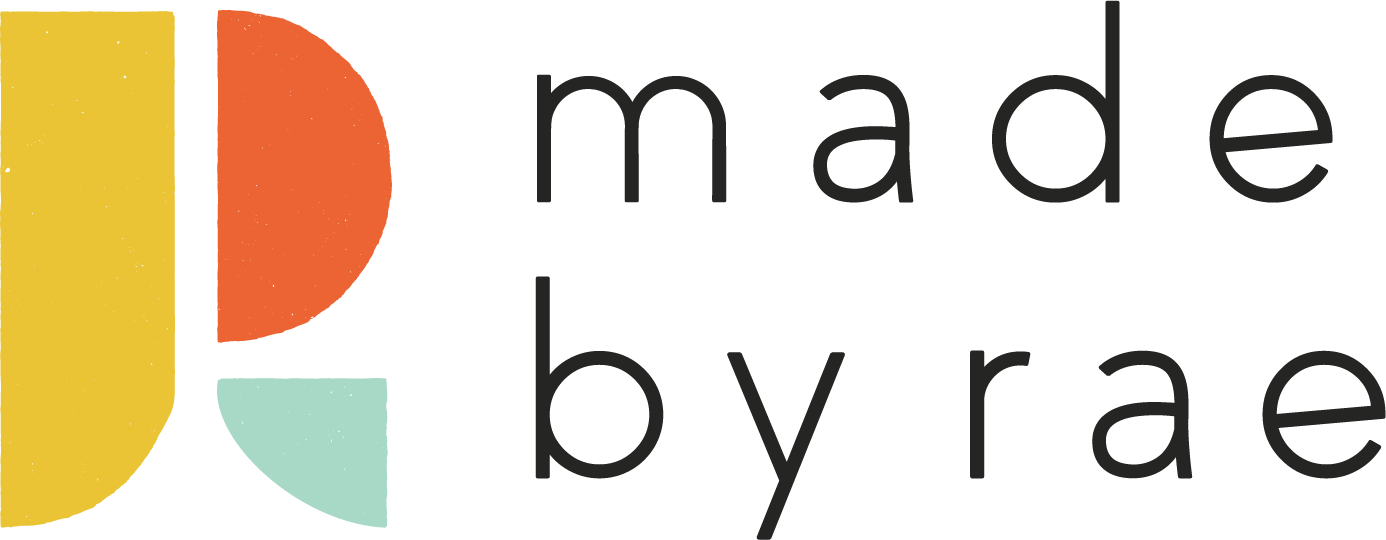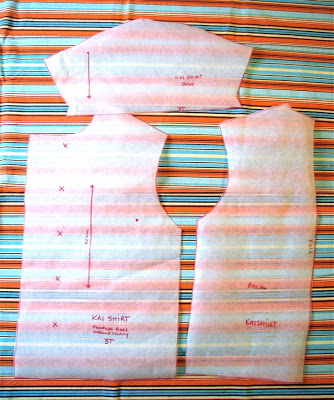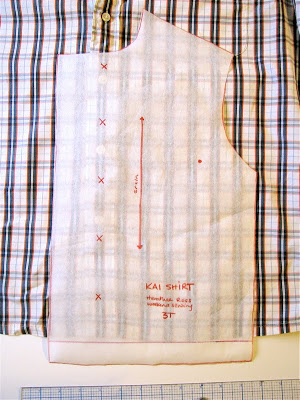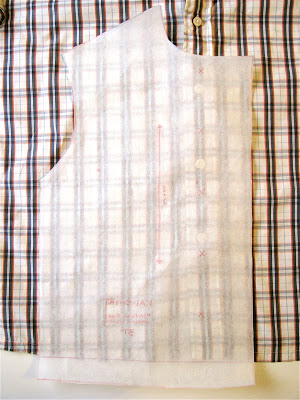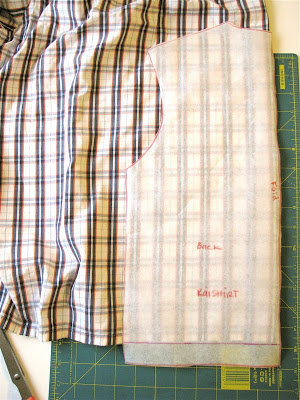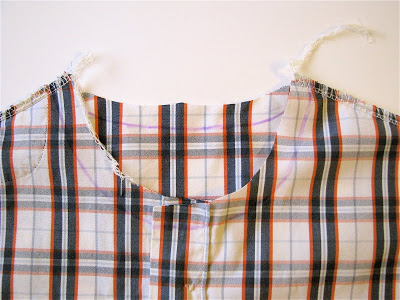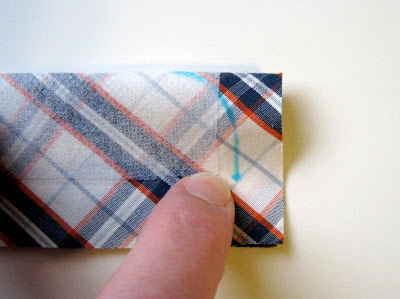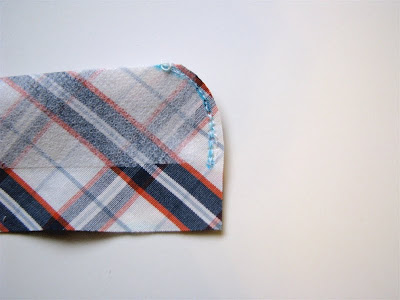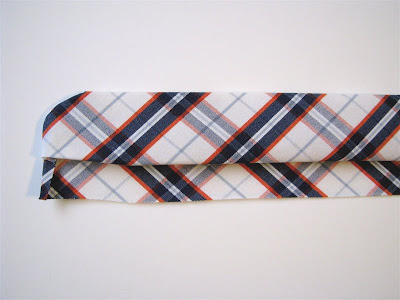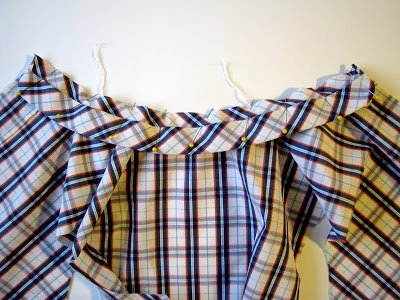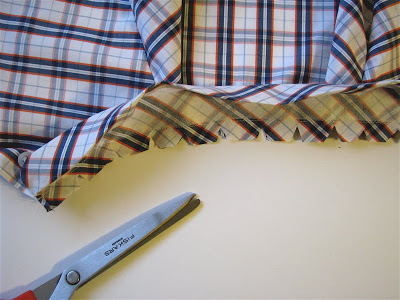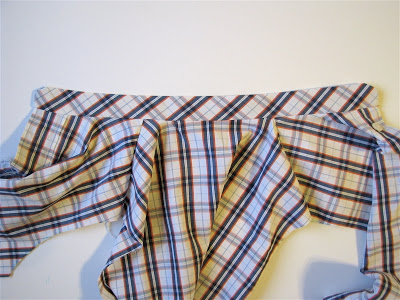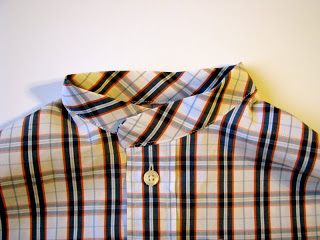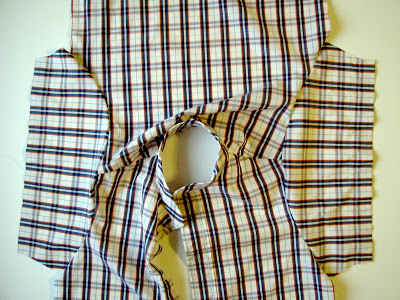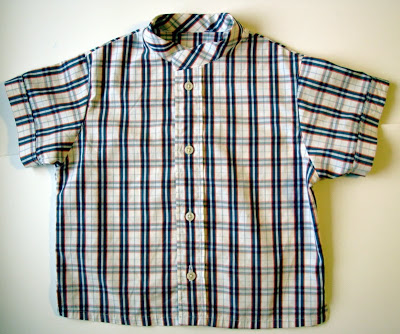Tutorial by Rae: Make a Men's Shirt into a Boy's Shirt
I'm going to to kick off the month with a tutorial for taking an old men's button-down shirt and turning it into a boy's short-sleeved shirt. This technique is simple and quick, and best of all, removes all of my least favorite things about making boy's shirts: making the button placket, sewing all those buttons and buttonholes (well, almost) and hemming! This drastically cuts down on the time it takes to complete a shirt which, for me, makes all the difference when it comes to getting it done.
Today I'll show how to make a basic shirt (above), and tomorrow I'll show you how to add the western flap pockets (below).

Step 2: Cut out the front
Lay the men's shirt on a flat surface, button it up, and smooth out the wrinkles. Find the "center front" on your front pattern piece. This is usually clearly marked on the pattern piece or has X's where the buttons will go. Position the pattern piece so that this line is directly over the buttons on the men's shirt. Next move the pattern piece down 1 inch (see line on pattern piece). Why? Since your shirt is already hemmed you don't need the hem allowance, which is almost always about an inch, give or take (Note: you may also want to pay attention to where the buttons fall on the pattern pieces; perhaps moving the pattern up or down just a little bit more to optimize button location). Trace with a marking pen. Turn the pattern over and repeat for the other front side. Cut these out, being careful not to cut into the back of the shirt.
Step 3: Cut the back
Fold the big shirt down the center back. Place the back pattern piece along the fold, shifting it down 1 inch as with the front. Trace and cut out.
Step 4: Cut out sleeve
Smooth out the sleeve. Fold sleeve pattern piece in half and place fold of sleeve directly over fold in sleeve. Again, you don't need the hem allowance, so move the pattern down so that the sleeve's edge ends at the pattern's hem line (Note: the sleeve hem line is usually marked or easy to find by the presence of an angle; I'm pointing to it with the pencil in the picture below).
Step 5: Sew shoulder seams
Take note of the pattern's seam allowance. Button the two front pieces together. With the right sides facing, sew back to front at shoulders using the specified seam allowance.
Step 6: Mark and measure collar seam line
Trace a line at the neckline seam allowance using a marking pen. Unbutton the shirt and make sure it goes all the way to the edges of the button plackets. Using a tape measure or piece of string, measure this line (it equals the collar length).
Step 7: Cut collar and collar interfacing
Cut out a rectangle on the bias for the collar (note the pattern is diagonal below). The width of the rectangle should be 2" plus 2 times the seam allowance. The length of the rectangle one inch LONGER than the collar length you just measured
Example: If you measured the collar length to be 14.5" in Step 6 and the seam allowance was 1/2":
WIDTH = 2" + 2(1/2") = 3"
LENGTH = 1" + 14.5" = 15.5"
So you would cut a rectangle 15.5" x 3".
Cut a piece of lightweight fusible interfacing 2" wide by the collar length (so 14.5" x 2" in our example). Center the interfacing over the collar fabric and iron to fuse. Note: the collar interfacing is optional, but it prevents the collar from flopping over while worn.
Step 8: Prepare collar
Fold collar in half lengthwise with interfacing out. Mark a curved line beginning 1/2" from each edge and curving towards center of collar.
Press, tucking sew allowance under along one side of collar.
Step 9: Attach collar to shirt
Pin collar to right side of neckline, with the folded side of collar facing away from shirt. Sew along seam allowance.
Clip seam.
Turn and press collar towards inside of shirt, tucking raw edges into collar.
Step 10: Attach sleeves
With right sides facing, attach sleeves to body of shirt. Press seam towards body of shirt and topstitch (even though it adds time, topstitching really makes it look nice!)
Step 11: Sew side seams
With right sides facing, sew side seams and sleeve underarm seams. Press, turn right-side-out, and admire!
Most men's shirts have a pretty big gap at the bottom where there is no button. To adapt this to a boy's shirt, you may have to add another button and buttonhole at the bottom of the shirt (as I did here). If you really loathe buttonholes, you could always sew in a small snap, but in my opinion this is more aesthetically pleasing.
That's all for today! Tomorrow we'll add western flap pockets. And don't forget to head over to MADE to see what Dana's up to today!
